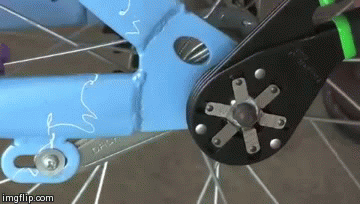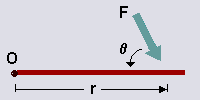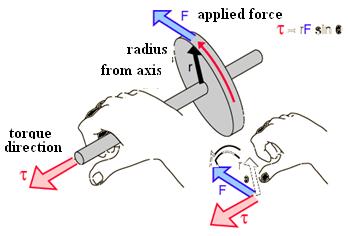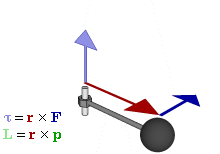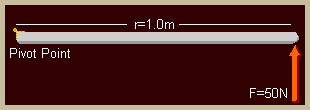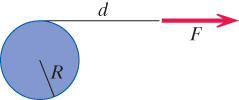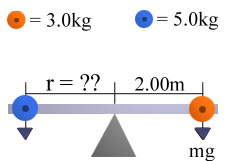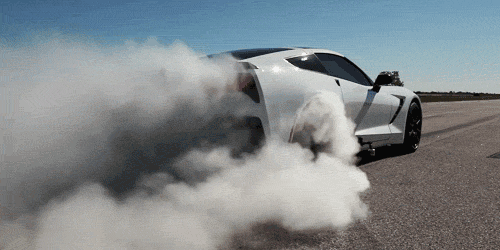Torque 2
Torque
Torque is a Latin word that roughly means "twist," and is usually symbolized by the lower case Greek letter tau ([math]\displaystyle{ \tau }[/math]). Torque is the measurement of how much a force, F, acting on an object will cause that object to rotate. This force is usually applied to an arm of some sort that is attached to a fulcrum or pivot point. For example, using a wrench to loosen or tighten a nut requires the use of torque - where the wrench would be the arm you apply the force to and the nut would be the pivot point that the force rotates around.
The Main Idea
In "Matter & Interactions, Fourth Edition," torque is defined as [math]\displaystyle{ \tau = r_{A} \times F }[/math] . Applying a torque to an object changes the angular momentum of that object. Torque, in angular momentum calculations, is analogous to [math]\displaystyle{ F_{net} }[/math] in regular momentum calculations. Just how a collection of forces acting on a system is summed and called [math]\displaystyle{ F_{net} }[/math], a collection of torques acting on a system is [math]\displaystyle{ \tau_{net} }[/math].
A Mathematical Model
Torque is defined as the cross product of the distance vector, the distance from pivot point to the location of the applied force, with an applied force. The magnitude of torque can be defined as such: [math]\displaystyle{ \tau_{net} = r_{A} \cdot F \cdot sin(\theta) }[/math]
Torque can also be defined as [math]\displaystyle{ \tau = \frac{dL}{dt} }[/math] , or the derivative of angular momentum, L. To determine the direction of torque, one can either compute the cross product or apply the "right-hand rule." To use the "right-hand rule," point your fingers in the direction of [math]\displaystyle{ r_{A} }[/math] and curl your fingers in the direction of F.
If your thumb points up, the force is coming out of the page and is in the positive z-directon. If your thumb points down, the force is going into the page and is in the negative z-direction. This is a right-handed system, and a good way to remember this is by the right-hand rule. This can also be applied to a "left-handed" system, but it is easier to first apply the right-hand rule and then flip the sign on one of the vector magnitudes to account for the different orientation (non-right-handed orientation).
A Computational Model
The above picture is a great example of what torque would look like in the real world. To make a similar simulation in vPython, all you would need to do is update position and angular momentum. The code would look something like this:
While t < some number:
[math]\displaystyle{ L = L + t_{net}\cdot \delta t }[/math]
[math]\displaystyle{ v = \frac{L}{mass} }[/math]
[math]\displaystyle{ r = r + v \cdot \delta t }[/math]
[math]\displaystyle{ t = t + \delta t }[/math]
where L is the angular momentum initialized earlier, [math]\displaystyle{ t_{net} }[/math] is the total torque, [math]\displaystyle{ \delta t }[/math] is the time step, and r is the original position.
Examples
Be sure to show all steps in your solution and include diagrams whenever possible
Simple
In a hurry to catch a cab, you rush through a frictionless swinging door and onto the sidewalk. The force you extered on the door was 50N, applied perpendicular to the plane of the door. The door is 1.0m wide. Assuming that you pushed the door at its edge, what was the torque on the swinging door (taking the hinge as the pivot point)?
(50N)(1.0m)sin(90) = 50 Nm
Middling
A uniform solid disk with radius 9 cm has mass 0.5 kg (moment of inertia I = ½MR2). A constant force 12 N is applied as shown. At the instant shown, the angular velocity of the disk is 25 radians/s in the −z direction (where +x is to the right, +y is up, and +z is out of the page, toward you). The length of the string d is 14 cm.
What are the magnitude and direction of the torque on the disk, about the center of mass of the disk?
(12N)(0.09m)= 1.08 Nm
Direction: -z direction because of the right hand rule
Difficult
We want to place another mass on the see-saw to keep the see-saw from tipping. The only other one we have is a 5.0kg mass. Where would we place this to balance the original 3kg mass that was placed 2.00m to the right of the pivot point?
(3kg)(9.8 m/s^2)(2.00m) = (5kg)(9.8 m/s^2)(x)
58.8 = 49x
x=1.2
Connectedness
How is this topic connected to something that you are interested in? I have a heavy interest in cars. More specifically, I love race cars, and I love watching Formula1, BTCC, WRC, and other car racing series. Torque, in cars, gives you an idea of how fast the car can accelerate. But more importantly, torque can make cars do this:
and this:
How is it connected to your major?
Torque is heavily related to mechanical engineering. Whether it be driving a conveyor belt in a factor, a driveshaft in a car, turning a wrench, or otherwise, torque is involved in almost all mechanical systems. Mechanical engineers use torque to transform energy into a useful form. For example, they use torque in electric motors to turn electric energy into rotational energy that can be used in all sorts of appliances. Mechanical engineers also take the chemical energy from gasoline combustion and turn it into torque to power planes, trains, and automobiles. Torque is applicable in all types of engineering.
Is there an interesting industrial application?
The amount of industrial applications of torque is nearly infinite, but one machine I find interesting is the lathe. The lathe uses torque and rotation to shape various materials [1]
History
The idea of torque originated with Archimedes studies on levers. Archimedes may not have invented the lever, but he was one of the first scientists to investigate how they work in 241 BC.
See also
Further reading
https://www.physics.uoguelph.ca/tutorials/torque/Q.torque.intro.html
External links
[4] [https://en.wikipedia.org/wiki/Torque [5]] [6]
